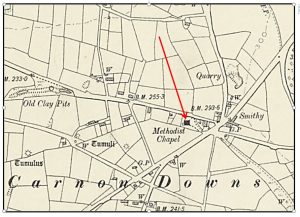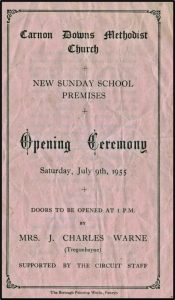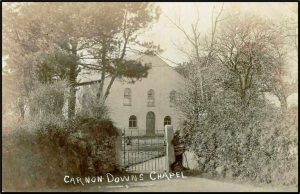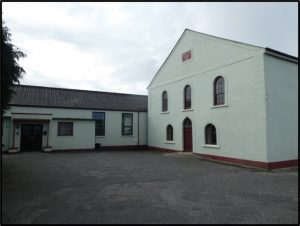
Carnon Downs is a village about three miles southwest of Truro on the A39 Truro to Falmouth road. This profile of Carnon Downs Wesleyan Chapel has been compiled by Phil Davey, Recorder of Carnon Downs Old Cornwall Society with the help of ‘A House on a Heath: The Story of Carnon Downs Chapel’ by E. Jane Irwin; and Thomas Trebilcock’s account of the chapel’s history, which he read at the centenary celebrations in 1925 and which he re-visited in a talk to the Wesley Guild in 1952.
1824: Mr. Edward Olive secured a lease from Lord Falmouth of a piece of land for a chapel. The lease was on three lives and according to the deed the chapel was expressly for the use of Wesleyan Methodists during the lives of William Roberts, aged 5, son of William and Juliana Roberts Penrose of Tregye; John, aged 6, son of John and Jane Dunstan, and Honor James, aged 6, daughter of Edward and Honor Olive, subject to rent of five shillings per year.

1825: The chapel was built at a total cost of £186.2.0 raised from donations, subscriptions and borrowing. Most of the costs are listed in the building account seen below.

1833: The chapel stood on unenclosed land until 1833 when £15 was spent on erecting a boundary hedge, which included a stile as an entry from Bissoe Road. Soon after this a stable was built to the west of the chapel. This was used during the week by a Mr. Morton and on Sundays it was used to shelter the preacher’s horse.
 OS Six Inch 1888-1913
OS Six Inch 1888-1913
1842: The western end of the chapel was taken down and the chapel was enlarged to seat 537. A new gallery was added. A service was held in the open air while the west wall was missing, with the congregation standing among the building materials.
1857: The distinguished musician Ralph Dunstan, who is remembered in Cornwall for his folk song collections, was born in Carnon Downs on November 17, 1857. At the age of 12 he joined the chapel choir and was keen to learn the instruments played at the time. In 1887 he entered the Westminster Training College as a Queen’s Scholar. He went on to become music master at Westminster and Southlands, Wesleyan colleges for men and women. Not least of Dr. Dunstan’s accomplishments was the writing of some 17 textbooks. His contribution to Cornish cultural studies came with his collection of Cornish music and folk songs. The publication of ‘The Cornish Song Book’ came in 1929 and ‘Cornish Dialect and Folk Songs’ followed three years later.
1862: Jane Irwin notes a mention in the 1862 accounts of “a vestry and schoolroom which brought in income from the Cattle Club and the Sick Club who rented it.” This appears to be the ‘old vestry’ referred to by Thomas Trebilcock in his 1952 talk as “the room over the present boiler and coke-house at the rear of the premises, the upper part of which, being dilapidated, was taken down 25 years ago.” This room had been used as a dame school, an evening school, a polling station for Feock Parish and as a men’s institute. Originally it was reached by a sloping ramp against the end wall of the chapel, with a wooden rail outside.
1870: In June the Royal Cornwall Gazette reported that the Carnon Downs Wesleyan Sunday School held its ‘annual festival’ at nearby Killiganoon House, where ‘about 230 children partook of tea and cake… The Sunday School teachers and visitors, numbering from three to four hundred, afterwards had tea in the same place….’ The Sunday School had been started by Edward Olive in his workshop even before the building of the chapel.
1885: The chapel lease expired with the death of Honor James Dunstan. Insurance payments had been made to cover this event but the insurance company became bankrupt and paid only one shilling in the pound. The debt was born by 14 members of the chapel and eventually paid off in 1916.
1895: In April 1895 the Royal Cornwall Gazette reported on renovations to the chapel, which had been closed for some time due to ‘…the failure of the south side wall. At the same time it was decided to make some alterations so as to improve the appearance and utility of the building. The windows have been altered from old fashioned squares to deep oblong with circular heads, and a new doorway has been cut in the eastern end for entrance to the chapel.’ Contractor for the work was Mr. W. H. Moyle of Chacewater, and the total cost estimated at £360. At this time the seating was also reduced to 335 by the construction of orchestra pews and classrooms in the upper storey of the west end. Until this time the singing had been led by wind instruments – cornet, flute, clarinet, euphonium, serpent and bassoon but soon the instrumental group were disbanded and a harmonium introduced.
1923: New heating was installed at a cost of £160.
1926: Part of the ‘old vestry’ referred to previously was pulled down.
1928: An organ was installed – built by Hele and Co. of Plymouth, also known as Hele and Sons, well-known organ builders in the south-west from 1865-2007. Among those present at the opening of the organ was Dr. Ralph Dunstan (referred to earlier) who played a selection of pieces including ‘The Vital Spark.’ The photograph below shows the chapel interior in 1906, before the installation of the organ.

1935: Electric lighting was installed at a cost of £52.
1940s: The Home Guard met in the chapel and between training and duty sang to raise funds for the war effort. At the end of the war the choir continued as the Carnon Vale Male Voice Choir which became well-known throughout the area.
1955: July 9 saw the opening of the new Sunday School Hall at a cost of about £4000. It was the only large meeting place in the village until the opening of the village hall in 1970 and became the centre for a number of local activities. Prior to this, the Sunday School met in the ground floor school room, the height of which had been reduced to accommodate the organ, and which, in the words of Jane Irwin… “was packed with children on Sundays…”
 The opening of the new Sunday School in 1955 – a luncheon for 316 was served.
The opening of the new Sunday School in 1955 – a luncheon for 316 was served.
Views of the chapel before the building of the Sunday School, and a more recent picture of the Sunday School, opened in 1955



 A new banner for the 1985 tea treat
A new banner for the 1985 tea treat
1997: A big freeze and thaw saw “water cascading from the roof space and a gentle swell from the cloakrooms,” writes Jane Irwin. The slate roof was replaced with asbestos tiles, the walls damp-proofed and the vestry was “cosy with carpet, tables and kitchen sink.”
 The chapel interior for the 2002 Flower Festival
The chapel interior for the 2002 Flower Festival
2019: Refurbishment of the Sunday School included the removal of the stage, the replacing of windows and the installation of a new kitchen. The hall continues to be an attractive meeting place for activities connected with the chapel and also for a number of other local organizations.
 Carnon Downs Chapel and Sunday School, February 2021. The chapel is a grade II listed building.
Carnon Downs Chapel and Sunday School, February 2021. The chapel is a grade II listed building.
